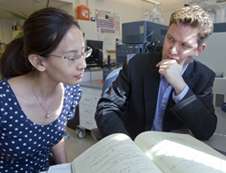The future of drug development

John Engen, associate professor of chemistry and chemical biology at the Northeastern University, is at the forefront of research that will advance drug discovery and development by making it easier to analyze certain kinds of proteins, their role in disease, and their interactions with drugs and each other.
Protein drugs, called biopharmaceuticals, represent the fastest growing segment of the pharmaceutical industry, Engen noted. His current research at Northeastern University’s Barnett Institute of Chemical and Biological Analysis has recently been featured in Chemical and Engineering News and the journal Nature.
Drug development is highly dependent on the study of proteins, particularly cell-membrane proteins, which account for 20 to 30 percent of all proteins in humans and represent nearly two-thirds of the proteins that can be targeted by drugs. However, these proteins are difficult to study because they are associated with lipids (molecules that make up the cell membrane). Most bioanalytical techniques are not compatible with the combination of lipids and proteins, especially those that are used to reveal the three-dimensional structure of proteins.
Engen’s recent work uses tiny slices of lipid, called nanodiscs, to develop a method to probe the structure of membrane proteins.
"Membrane proteins can be inserted into the nanodiscs, which look like little Frisbees, in a way that mimics how they are found in cells," said Engen. "Since the nanodiscs are much more compatible with many existing bioanalytical methods, it is then possible to study the shape of the proteins that are in the discs."
Engen’s research, in collaboration with Waters Corporation of Milford, Mass., has led to the development of a new instrumental system for the analysis of proteins using Ultraperformance Liquid Chromatography (UPLC).
UPLC, including a specialized version that reveals the three-dimensional shape of proteins, represents the future of separation science, said Engen. "We can study important things like how proteins participate in disease, how drugs interact with proteins, protein complexes, and how protein drugs behave during manufacturing."
Recently Engen, in collaboration with researchers at Harvard Medical School and the Dana-Farber Cancer Institute, used the specialized UPLC system to help understand the inhibition mechanism of a new type of anti-leukemia drug.
Provided by Northeastern University
















